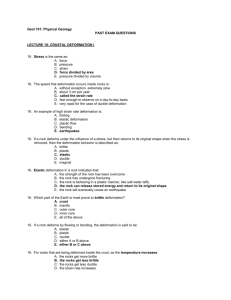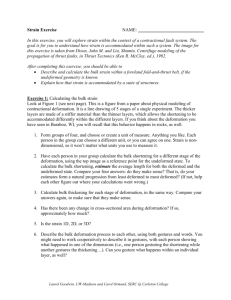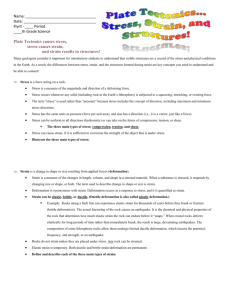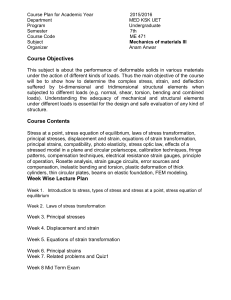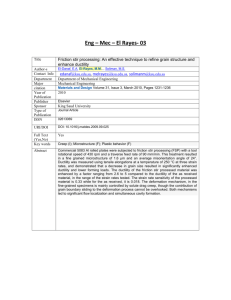Rheology and Stress
advertisement
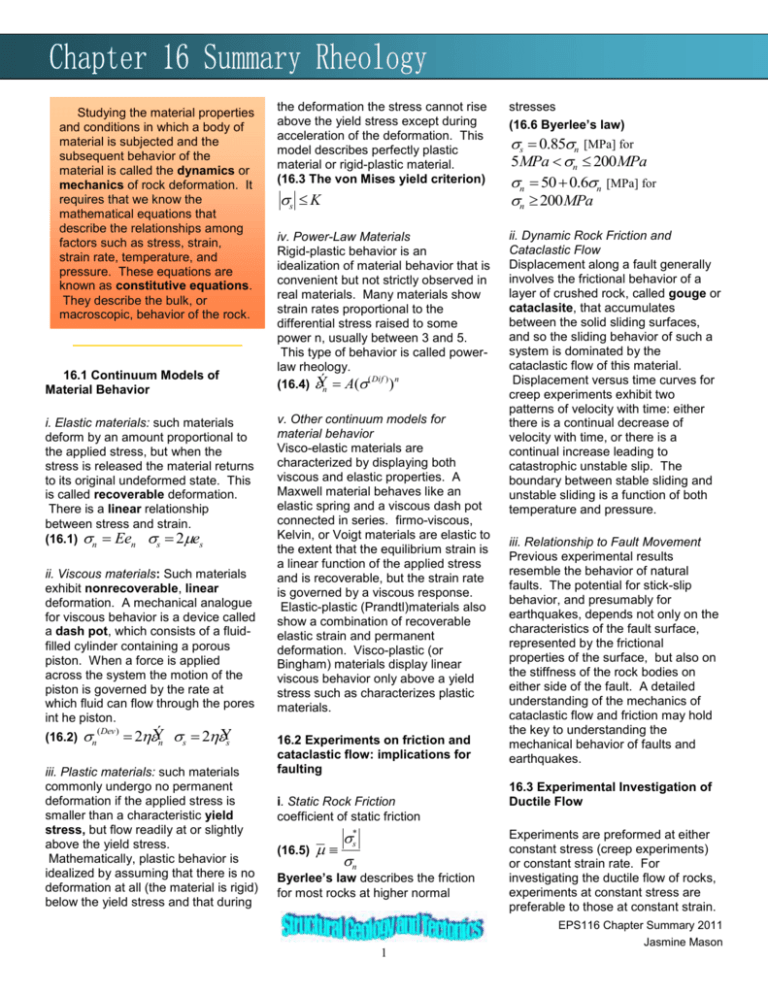
Studying the material properties and conditions in which a body of material is subjected and the subsequent behavior of the material is called the dynamics or mechanics of rock deformation. It requires that we know the mathematical equations that describe the relationships among factors such as stress, strain, strain rate, temperature, and pressure. These equations are known as constitutive equations. They describe the bulk, or macroscopic, behavior of the rock. 16.1 Continuum Models of Material Behavior i. Elastic materials: such materials deform by an amount proportional to the applied stress, but when the stress is released the material returns to its original undeformed state. This is called recoverable deformation. There is a linear relationship between stress and strain. (16.1) n Een s 2es ii. Viscous materials: Such materials exhibit nonrecoverable, linear deformation. A mechanical analogue for viscous behavior is a device called a dash pot, which consists of a fluidfilled cylinder containing a porous piston. When a force is applied across the system the motion of the piston is governed by the rate at which fluid can flow through the pores int he piston. (16.2) Ýs Ýn s 2 n(Dev) 2 iii. Plastic materials: such materials commonly undergo no permanent deformation if the applied stress is smaller than a characteristic yield stress, but flow readily at or slightly above the yield stress. Mathematically, plastic behavior is idealized by assuming that there is no deformation at all (the material is rigid) below the yield stress and that during the deformation the stress cannot rise above the yield stress except during acceleration of the deformation. This model describes perfectly plastic material or rigid-plastic material. (16.3 The von Mises yield criterion) s K iv. Power-Law Materials Rigid-plastic behavior is an idealization of material behaviorthat is convenient but not strictly observed in real materials. Many materials show strain rates proportional to the differential stress raised to some power n, usually between 3 and 5. This type of behavior is called powerlaw rheology. Ýn A((Dif ) ) n (16.4) v. Other continuum models for material behavior Visco-elastic materials are characterized by displaying both viscous and elastic properties. A Maxwell material behaves like an elastic spring and a viscous dash pot connected in series. firmo-viscous, Kelvin, or Voigt materials are elastic to the extent that the equilibrium strain is a linear function of the applied stress and is recoverable, but the strain rate is governed by a viscous response. Elastic-plastic (Prandtl)materials also show a combination of recoverable elastic strain and permanent deformation. Visco-plastic (or Bingham) materials display linear viscous behavior only above a yield stress such as characterizes plastic materials. 16.2 Experiments on friction and cataclastic flow: implications for faulting i. Static Rock Friction coefficient of static friction (16.5) *s n Byerlee’s law describes the friction for most rocks at higher normal 1 stresses (16.6 Byerlee’s law) s 0.85n [MPa] for 5MPa n 200MPa n 50 0.6n [MPa] for n 200MPa ii. Dynamic Rock Friction and Cataclastic Flow Displacement along a fault generally involves the frictional behavior of a layer of crushed rock, called gouge or cataclasite, that accumulates between the solid sliding surfaces, and so the sliding behavior of such a system is dominated by the cataclastic flow of this material. Displacement versus time curves for creep experiments exhibit two patterns of velocity with time: either there is a continual decrease of velocity with time, or there is a continual increase leading to catastrophic unstable slip. The boundary between stable sliding and unstable sliding is a function of both temperature and pressure. iii. Relationship to Fault Movement Previous experimental results resemble the behavior of natural faults. The potential for stick-slip behavior, and presumably for earthquakes, depends not only on the characteristics of the fault surface, represented by the frictional properties of the surface, but also on the stiffness of the rock bodies on either side of the fault. A detailed understanding of the mechanics of cataclastic flow and friction may hold the key to understanding the mechanical behavior of faults and earthquakes. 16.3 Experimental Investigation of Ductile Flow Experiments are preformed at either constant stress (creep experiments) or constant strain rate. For investigating the ductile flow of rocks, experiments at constant stress are preferable to those at constant strain. EPS116 Chapter Summary 2011 Jasmine Mason The homologous temperature is defined by the ratio of the temperature of the material to its melting temperature. Cold working is the deformation at homologous temperatures below about .5. Deformation at homologous temperatures above .5 is called hot working. Decreasing creep rate at constant stress is called work hardening or strain hardening. In this phase of the deformation, the material becomes less ductile with increasing strain. 16.4 Steady-State Creep Steady state or secondary creep occurs when the creep rate stabilizes the at a constant value. It represents long-term deformation processes that occur within the Earth. These different creep laws reflect the different processes that dominate at different levels of stress. i. The Moderate-Stress Regime: Power-Law Creep The constitutive equation that accounts for most moderate-stress steady-state deformation observed in the lab is the power-law equation. (16.7) (Dif ) Ýn(ss) A1 ((Dif ) ) n exp[ Ý(ss) K1 n 1/ n * E ] RT E* exp[ ] nRT ii. The High-Stress Regime: The Exponential Creep Law At high stresses, the strain rate becomes increasingly sensitive to differential stress as the stress increases. (16.9) Ýn(ss) A2 exp[ (Dif ) ]exp[ E * ] RT iii. The Low-Stress Regime: PowerLaw Creep with Low n At differential stresses roughly below 20MPa, the constitutive equation is similar to (16.7) but in this case the stress exponent n commonly has a value between 1 and 2. 16.5 The Effects of Pressure, Grain Size, Chemical Environment, and Partial Melt on Steady-State creep i. The Effect of Pressure Pressures at crustal depths can be ignored. However, within the mantle, pressure effects become more important. Adding a pressure term into (16.7) includes the effects of pressure on steady-state creep. (16.11) Ýn(ss) A4 ((Dif ) ) n exp[ (E * pV * ) ] RT ii. The Effect of Grain Size When coarse grained solids are deformed at low homologous temperatures in the moderate to high stress regime, the yield stress tends to decrease slightly with increasing grain size. The opposite effect is observed for fine-grained materials in the low-stress regime. (16.15) Ýn(ss) A6 d b ((Dif ) ) n exp[ (E * pV * ) ] RT iii. The Effects of Chemical Environment The chemical environment of deformation has a huge effect on the rheology of rocks, in particular the fugacities of water and oxygen. Water weakening or hydrolytic weakening is the solution of water in the lattices of silicates at elevated temperatures and pressures that reduces the activation energy for creep. (16.18) (E * pV * ) Ýn(ss) A7 d b f Hr 2O ((Dif ) ) n exp[ ] RT iv. The Effect of Partial Melt The effect of a partial melt on a body of rock is most pronounced if the melt wets the boundaries of the mineral grains in the rock and least pronounced if the melt collects in pores at grain corners. i. Interpretation of Structures of Ductile Deformation with Relation to Finite Strain, Instantaneous Strain Rate, and Stress It is preferable to discuss the origins of deformational structures in terms of the orientation of the principal finite strains. This is because they provide information about the finite strain, which is the sum of all the deformations that a given body of rock has experienced, and in general, they do not provide information about the strain rate or instantaneous strain. Experiments have mostly been done on monomineralic rocks, and experiments on polymineralic rocks have not been entirely successful because a small percentage of a significantly weaker mineral can strongly affect the ductile behavior of a rock. The difficulty in predicting this fundamentally restricts our attempts to model accurate the behavior of Earth Materials. ii. Experimental versus Geologic Strain Rates Geologic strain rates are generally 4 to 10 orders of magnitude lower than the experimental rates. How, then, can we tell whether the constitutive equations we determine in the lab are pertinent to geologic deformation? First, you can look at microscopic and submicroscopic structures in the crystal lattices that characterize the operation of deformation mechanisms. If similar microstructures are found in nature, then we can conclude that the same mechanisms operated under the two sets of conditions. Secondly, one can compare observed natural deformation rates with the predictions based on lab determined constitutive equations. References & Resources Robert J. Twiss, Eldridge M. Moores, Structural Geology 2nd edition, (W. H. Freeman), p. 297-317, 2006 16.6 Application of Experimental Rheology to Natural Deformation EPS116 Chapter Summary 2011 Jasmine Mason 2
